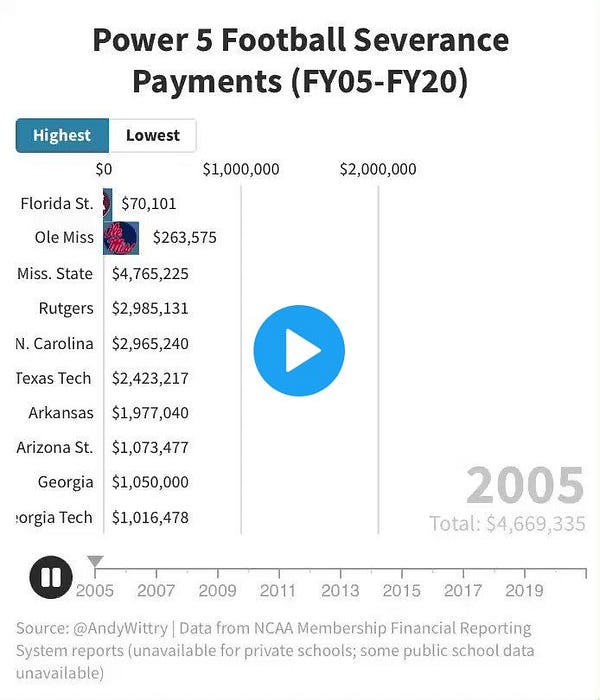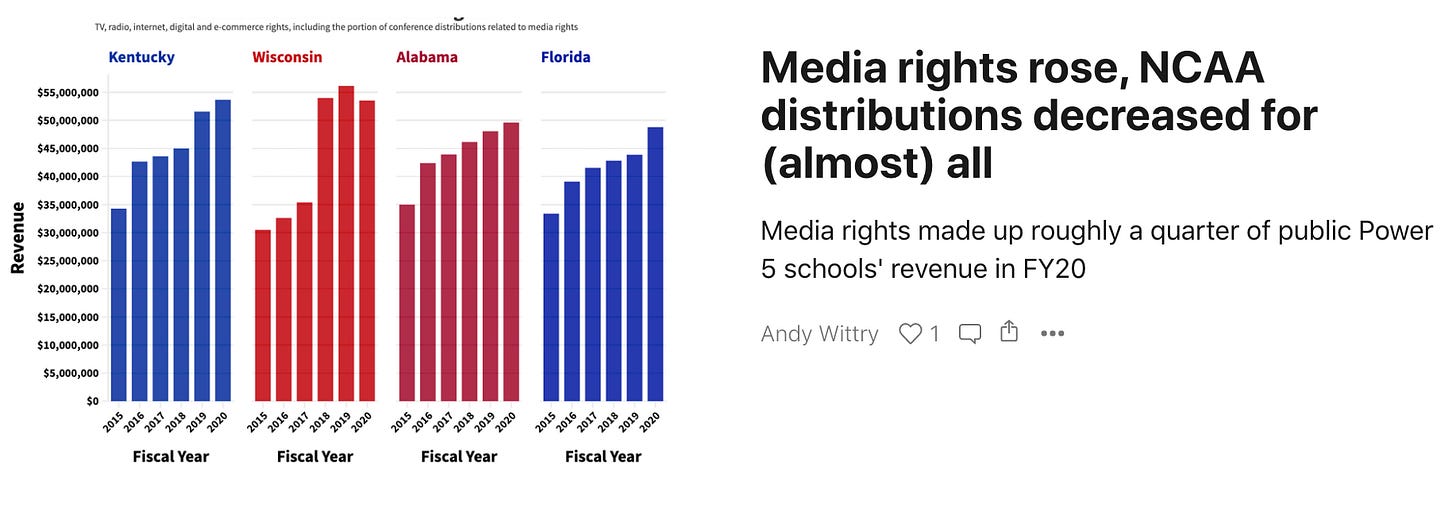Power 5 spending on coaches, support staff increased by average of $1.7M per school in the 2020 fiscal year
A record percentage of schools *didn't* spend any money on men's basketball buyouts. A record percentage paid football severance, however.
Welcome back to Out of Bounds, a free, weekly newsletter about college athletics. Feedback, tips and story ideas are always welcome at andrew [dot] wittry [at] gmail [dot] com or you can connect with me on Twitter.
On Tuesday, I published Part I of a series that’s analyzing public Power 5 institutions’ reported revenue and expenses from the 2020 fiscal year and Part II analyzed the increasing value of media rights, along with the decreases in NCAA distributions and contributions.
Today’s newsletter – Part III – focuses on Power 5 schools’ reported spending on coaches’ and support staff members’ salaries, benefits and bonuses, as well as severance payments. The data was compiled from NCAA Membership Financial Reporting System (FRS) reports, which Division I institutions are required to file annually. The 2020 fiscal year ran from July 1, 2019 through June 30, 2020.
On average, public Power 5 schools spent roughly $761,000 more per school on coaching salaries, benefits and bonuses in the 2020 fiscal year compared to 2019. Their financial reports show an even larger average year-over-year increase in spending on the compensation, benefits and bonuses for support and administrative staff – roughly $940,000 more per school compared to the previous year.
Forty-seven of the 52 athletic departments examined increased their respective year-over-year spending on support staff from FY19 to FY20, while 38 increased their respective spending on coaches’ salaries.
In total, the 52 Power 5 schools examined reported spending a combined $88.5 million more on coaches and support staff in FY20 compared to the previous fiscal year. These expense categories don’t reflect coaching salaries, benefits and bonuses, or support staff/administrative compensation, benefits and bonuses that were paid by a third party.
Of note is that Michigan State increased its spending on coaches’ salaries by $8.6 million, or 36 percent, from $23.7 million in FY19 to $32.4 million in FY20, including $18.6 million that went to the university’s football coaching staff alone in the 2020 fiscal year (compared to $10 million the year prior). Former head coach Mark Dantonio received a $4.3-million retention bonus by remaining at the university through Jan. 15, 2020, then he retired on Feb. 4, 2020.
Ole Miss increased its reported year-over-year spending on coaches by $4.9 million, or almost 24 percent, from $20.8 million in FY19 to $25.7 million in FY20.
On the support staff side, LSU (+$3.4 million), Clemson (+$2.6 million), Georgia Tech (+$2.6 million), Ohio State (+$2.6 million), Michigan State (+$2.3 million) and Rutgers (+$2.2 million) each increased their respective year-over-year spending on support staff by at least $2 million. LSU, Clemson and Ohio State have each won at least one college football national championship during the College Football Playoff era, while Ohio State’s divisional opponents Michigan State and Rutgers each hired a new football coach – Mel Tucker and Greg Schiano, respectively – during the 2020 fiscal year.
As I wrote in the spring in an analysis of athletic departments’ increasing revenue and expenses, there’s almost a one-to-one relationship between athletic department revenue and expenses, and an increasing percentage of the pie, which itself is increasing, is going to coaches and support staff. That newsletter featured the graph below, which shows how the average annual salaries of Big Ten coaches have increased over time.
Often smaller, and fewer, severance payments
The COVID-19 pandemic, which led to the cancelation of the NCAA men’s and women’s basketball tournaments, plus NCAA spring championships, played a role in a quieter men’s basketball coaching carousel in the spring of 2020. Former Wake Forest head coach Danny Manning was the only high-major coach to lose his job during that spring.
Plus, spring sports seasons barely got off the ground, almost assuredly taking a without-cause firing of a baseball, beach volleyball, golf, lacrosse, rowing, softball, tennis, outdoor track and field, men’s volleyball or women’s water polo coach off the table.
Dating back to the 2005 fiscal year, the 2020 fiscal year marked the highest single-year percentage of public Power 5 schools that didn’t report any spending on severance payments to former men’s basketball coaches or staff members, as 43 of the 52 public Power 5 schools, or 82.7 percent, didn’t pay any severance, as the pandemic ended the college basketball season early.

However, that relationship wasn’t true for the 2019 college football season, which is the most recent season for which there are FRS reports. While men’s basketball saw the highest percentage of public Power 5 schools that didn’t pay any severance, last fiscal year simultaneously marked the lowest percentage of public Power 5 schools that didn’t pay any severance related to their football programs since the 2005 fiscal year.
Only 20 of the 52 schools, or roughly 38 percent, had a clean sheet.
You can view the updated database of public Power 5 schools’ latest financial data here.
While roughly 15 years ago, two-thirds of Power 5 schools didn’t spend any money on football-related severance payments in a given year, now nearly two-thirds of Power 5 schools spend something on football-related severance in a given year.
Among the 32 schools that reported paying football-related severance in FY20, their average payment was more than $1.6 million, down from a record-$3.4 million among severance-paying schools in FY18 and $2 million in FY19.

For the 2020 fiscal year, the average expenses related to severance payments per public Power 5 school – across all sports, plus athletic department administration – was roughly $1.2 million, down almost $375,000 from the average of $1.6 million in 2019.
The Power 5 schools examined reported more than $85 million in severance payments in the 2019 fiscal year, compared to just over $66 million in 2020. Florida State alone was responsible for more than $19 million of that 2020 total, or almost 29 percent, most of which was owed to former head football coach Willie Taggart and his staff.
Florida State’s spending on severance payments to former football coaches in the 2020 fiscal year also set a new record for the greatest single-year severance total in a database containing more than 700 entries that has been compiled by Out of Bounds, topping Louisville’s mark of $16,999,251 from the year before.


Also of note is the combined severance payments made by the participants in the 2019 Egg Bowl, which ended in Mississippi State defeating rival Ole Miss 21-20 after former Ole Miss wide receiver Elijah Moore celebrated a fourth-quarter touchdown catch by getting on all fours and pretending to pee like a dog, resulting in a penalty and Ole Miss missing the game-tying, extra-long, extra-point attempt with two seconds left. Both schools ultimately fired their head coaches.
The combined football-related severance payments paid during the 2020 fiscal year by the two SEC institutions in Mississippi – $10,688,489 – represented more than 16 percent of the total severance payments that the 52 public Power 5 schools paid during the 2020 fiscal year across all sports, plus athletic department administrators.
It should come as no surprise that football coaches were the primary recipients ($52.9 million) of severance payments during the 2020 fiscal year, making up 80 percent of public Power 5 schools’ total severance for the year. Men’s basketball accounted for just $7.1 million in severance, or just shy of 11 percent of the total, while women’s basketball was responsible for only $345,135, or 0.5 percent of the total severance paid across all sports.
While football-related severance payments were 4.8-times greater than men’s basketball severance payments in both the 2018 and 2019 fiscal years, they were 7.4-times greater in the 2020 fiscal year, due to the pandemic and canceled NCAA tournament. Despite the limited amounts paid in men’s basketball severance payments, they were still collectively 20.7-times greater than women’s basketball severance payments during the 2020 fiscal year.
The bar graph below shows the reported severance spending for all 52 public Power 5 schools during the 2020 fiscal year, showing the extent to which college football is responsible for the majority of severance payments.
(Click on the graphic below to open an interactive version in a new window)
The 2020-21 college football coaching hiring and firing cycle suggests that the pandemic didn’t necessary slow coaching turnover or limit the willingness of athletic departments and their donors to spend money on severance payments. As I wrote last December, the college football coaching carousel essentially found historical equilibrium – financial losses from declines in contributions, ticket sales, concessions and parking be damned, not to mention the cost-saving personnel decisions that many athletic departments had previously made.
When the final sum of college football severance payments is calculated from the 2020 college football season, which will be reflected in FRS reports for the 2021 fiscal year, the amount of spending on severance payments could be one of the two highest totals in the sport’s history. The current high-water mark is the 2017-18 coaching cycle, when the 52 public Power 5 schools spent a combined $98.8 million on football buyouts in one fiscal year. That year, 12 of the 52 schools examined spent at least $1 million on football buyouts and 29 of the 52, or 55 percent, spent something on severance payments for former football coaches. Eight spent at least $7 million.
The pandemic showed that as long as the money is available – from someone, somewhere – underperforming college football coaches will continue to be paid generational sums of wealth to not coach football, potential optics be damned.
In case you missed the last newsletter
(Click the image below to read)
“The two conferences whose members reported the most valuable media rights, on average – the SEC and Big Ten – also saw the value of their media rights increase during the 2020 fiscal year, according to their FRS reports, while two of their peer conferences in the Power 5 – the ACC and Big 12 – reported average year-over-year decreases in their media rights revenue.”
Read the full newsletter here.
Thank you for reading this edition of Out of Bounds with Andy Wittry. If you enjoyed it, please consider sharing it on social media or sending it to a friend or colleague. Questions, comments and feedback are welcome at andrew.wittry@gmail.com or on Twitter.






